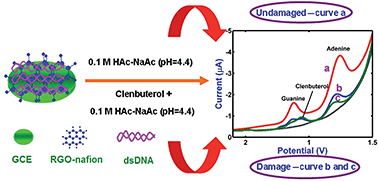Electrochemical detection of DNA damage induced by clenbuterol at a reduced graphene oxide-Nafion modified glassy carbon electrode
Abstract
An electrochemical biosensor capable of direct detection of DNA damage induced by clenbuterol (CLB) has been developed. A glassy carbon electrode (GCE) was modified using reduced graphene oxide-Nafion and dsDNA to produce a dsDNA/RGO-Nafion/GCE sensor. The modified electrode was characterized by electrochemical impedance spectroscopy (EIS) and cyclic voltammetry (CV), and the results at each stage of the electrode construction were interpreted. They indicated that the electrochemical oxidation peak currents of guanine and adenine at the electrode (dsDNA/RGO-Nafion/GCE) significantly increased as compared with those at the untreated electrode (dsDNA/GCE). Based on this, the sensor was used to measure the change of the oxidation peak currents for guanine and adenine between the intact and damaged dsDNA in the sensor films, and the DNA damage was successfully detected. Furthermore, the plot of peak current decline for the guanine and adenine versus the concentration of CLB was linear in the range of 5.0 × 10−7 to 4.0 × 10−6 mol L−1, with a limit of detection (LOD) of 3.2 × 10−7 mol L−1, which provided a good method to determine CLB indirectly.



 Please wait while we load your content...
Please wait while we load your content...